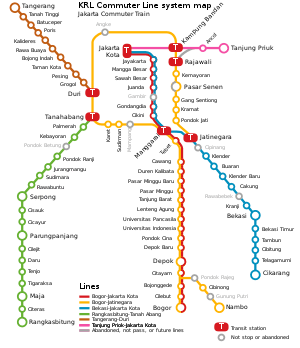KRL Commuterline
KRL Commuterline, or commonly known as Commuterline or KRL by Indonesians, is a commuter rail system for Greater Jakarta in Indonesia. It was previously known as KRL Jabodetabek.
 | |||
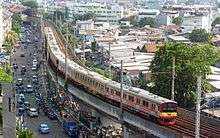 A 205 series owned by KRL in service on Red Line | |||
| Overview | |||
|---|---|---|---|
| Native name | Kereta Rel Listrik (KRL) Jabodetabek | ||
| Owner | PT Kereta Api Indonesia (KAI) | ||
| Locale | Jakarta Metropolitan Area | ||
| Transit type | Commuter Rail | ||
| Number of lines | 6 | ||
| Number of stations | 80 (6 inactive) | ||
| Daily ridership | 0.95 million (2017)[1] (Highest 1.014 million, May 2017)[2] | ||
| Annual ridership | 315.8 million (2017)[3][4] | ||
| Headquarters | Stasiun Juanda, Jalan Ir. H. Djuanda I, Jakarta, 10120, Indonesia | ||
| Website | http://www.krl.co.id/ | ||
| Operation | |||
| Began operation | 6 April 1925 (Netherlands Indian Electric State Railways Tandjoengpriok–Meester Cornelis line); 1999 (under PT Kereta Api, as "Jabotabek Urban Transport Division"); 15 September 2008 under PT KAI Commuter Jabodetabek (KCJ); since 20 September 2017 under PT Kereta Commuter Indonesia (KCI) | ||
| Operator(s) | PT Kereta Commuter Indonesia (KCI) | ||
| Train length | 8, 10 or 12 cars per trainset | ||
| Headway | 3 minute(s)- 1hour (Some routes) | ||
| Technical | |||
| System length | 418 km (260 mi)[5] | ||
| Track gauge | 1,067 mm (3 ft 6 in) | ||
| Electrification | 1,500 V DC overhead catenary | ||
| Top speed | 90 km/h (55 mph) | ||
| |||
 | |
Formerly | PT KAI Commuter Jabodetabek |
|---|---|
| Private PT | |
| Industry | Rail transport |
| Predecessor | Jabotabek Division of PT Kereta Api Indonesia (Persero) |
| Founded | September 15, 2008 in Jakarta |
| Headquarters | Juanda Station, , |
Area served | Greater Jakarta |
| Products | Rail transport in Greater Jakarta |
| Parent | PT Kereta Api Indonesia (Persero) |
| Website | www |
It is operated by PT Kereta Commuter Indonesia (KCI), a subsidiary of the Indonesian national railway company PT Kereta Api Indonesia (KAI). The name of the operator changed from previous PT Kereta Commuter Jakarta (KCJ) since 19 September 2017.[6]
The rail system uses second-hand EMUs formerly used in Japan (in particular, Kantō region railways) and operates at high frequency with a minimum headway of three minutes. As of November 2018, the average number of KRL users per day reaches average of 1.04 million, with a record of the highest number of users served in one day is 1,154,080.[7] The number is targeted to reach 1.2 million passengers per day by 2019.[8][9]
History
Colonial era
In 1917, a plan to introduce electrified railway in Batavia was made by Staatspoorwegen (SS), Dutch colonial railways company. The railway between Tanjung Priok to Meester Cornelis (Jatinegara) was the first line to be electrified. The construction began in 1923 and completed on 24 December 1924. The line was opened on 6 April 1925—in time for the SS 50th anniversary—with 3000-series locomotives from SLM–BBC (Swiss Locomotive and Machine Works - Brown Boveri & Cie), 3100-series electric locomotives from AEG Germany, 3200-series locomotives from Werkspoor Netherlands and passenger coaches from Westinghouse and General Electric.[10]
The electrification project continued and on 1 May 1927, all rail lines that surround Batavia has been fully electrified. Batavia Zuid station (now Jakarta Kota), closed temporarily in 1926, was reopened on 8 October 1929. The last part of the electrification project, Batavia Zuid - Buitenzorg, was completed in 1930.[11] After independence in 1945, the railway operation was taken over by DKA (Djawatan Kereta Api Repoeblik Indonesia/ Indonesian Railways Bureau, now PT Kereta Api).
Decline and revival
Transportation in Jakarta was at its lowest point during the 1960s. Tramways in Jakarta were closed in 1960 and railway traffic on Manggarai – Jakarta Kota was restricted in November 1966. The electric train services were closed in late 1965.[12]
Electric service was revived in 1972. On 16 May 1972, PNKA (Perusahaan Negara Kereta Api, successor of DKA) ordered 10 new sets of electric multiple units from Japan. The new trains, built by Nippon Sharyo, arrived in 1976 and replaced the old locomotives and coaches. Sets consisted of four cars each, with capacity of 134 passengers per car. Those new trains (commonly known as KRL Rheostatik) will continue serving the passengers in Jakarta for the next 37 years.[12] PNKA (later PJKA and Perumka) continued importing trains from Japan, South Korea and Netherlands until the late 1990s.
In May 2000, the government of Japan via JICA and Tokyo Metropolitan Government donated 72 units of used Toei 6000 trains, formerly operating on Toei Mita Line. These were the first air-conditioned electric trains in Indonesia. The new trains were operated on 25 August 2000 for express services.[13]
Commuter Line era

The current form of electric train service in Jakarta was begun in 2008. Jabotabek Urban Transport Division, a sub-unit of Kereta Api Indonesia that handles commuter service around Jabodetabek, spun-off to form KAI Commuterline Jabodetabek (KCJ). Ticket revenues, rolling stock maintenance, and station management was transferred to the newly formed subsidiary, but all operational matters (e.g. scheduling and dispatching), rolling stock, stations and infrastructures remained under KAI's responsibility.
The modernization of the commuter railway system, however, did not begin until 2011. In 2011, network operations were greatly simplifed from 37 point-to-point service patterns into six integrated lines (known as Loop line system) all running local, stopping at every station, as express services were abolished. Service was also simplified into two service classes: economy class (cheaper service without air conditioning, subsidized by Ministry of Transportation) and Commuter class (more expensive service with air conditioning). On 17 April 2013, the commuter line extension to Maja in the Green Line commenced operation.[14] On 25 July 2013, the economy class was discontinued, leaving the Commuter class as the sole service class throughout the network.[15] In July 2013, the operator introduced the Commet (Commuter Electronic Ticketing) system replacing the old paper ticket system and changing the old fare system into 'progressive fare' system, as well as modernization of all 80 serving stations.
Starting on 1 April 2015, the Nambo line extension operation is commenced.[16][17]Three line extensions have been opened between 2015 and 2017: the extension of Pink Line to Tanjung Priuk station which commenced operation on 22 December 2015,[18] the extension of Green Line to Rangkasbitung station which commenced operation on 1 April 2017,[14] and the extension of Blue Line to Cikarang station which commenced operation on 8 October 2017.[19] In July 2015, KA Commuter Jabodetabek served more than 850,000 passengers per day, which is almost triple the 2011 figures, but still less than 3.5% of all Jabodetabek commutes.[20]
Until 5 March 2014, KA Commuter Jabodetabek only operates 8-car trainsets on all lines.[21] In 2016, the operation of 12-car trainsets commenced.[22] As of December 2019, it operates 1,057 trips per day by 90 trains.[23]
Service routes
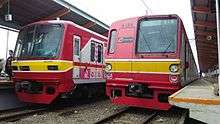
The modernization project in 2011 introduced 6 integrated commuter lines and 8 services which serve Greater Jakarta. The number of services has increased to 11 by 2017.
The network route map is recognized by color code and destination of final station.
| Lines | Services | No. of stations | Length | Opened | Operated as
KCI Line |
|---|---|---|---|---|---|
| Jakarta Kota to Depok | 20† | 33.3 km (20.7 mi) | 1930 | 5 December 2011[24] | |
| Jakarta Kota to Bogor | 24† | 54.8 km (34.1 mi) | 1930 | ||
| Jatinegara to Depok | 26 | 47.2 km (29.3 mi) | 1987 | ||
| Jatinegara to Bogor | 30 | 69.4 km (43.1 mi) | 1987 | ||
| Angke to Nambo | 21 | 51.4 km (31.9 mi) | 1997 | 1 April 2015[25] | |
| Tanah Abang to Serpong | 8 | 19.6 km (12.2 mi) | 1899 | 5 December 2011[24] | |
| Tanah Abang to Parung Panjang | 11 | 24.3 km (15.1 mi) | 1899 | ||
| Tanah Abang to Maja | 17 | 55.6 km (34.5 mi) | 1899 | 17 April 2013[14] | |
| Tanah Abang to Rangkasbitung | 19 | 72.8 km (45.2 mi) | 1899 | 1 April 2017[26] | |
| Jakarta Kota to Bekasi via Manggarai | 18† | 27.4 km (17.0 mi) | 1930 | 5 December 2011[24] | |
| Jakarta Kota to Bekasi via Pasar Senen | 15 | 26.5 km (16.5 mi) | 2017 | 1 April 2017[27] | |
| Jakarta Kota to Cikarang | 21† | 44 km (27 mi) | 2017 | 8 October 2017[19] | |
| Duri to Tangerang | 11 | 19.2 km (11.9 mi) | 1899 | 5 December 2011[24] | |
| Jakarta Kota to Tanjung Priuk | 4 | 9.8 km (6.1 mi) | 1885 | 5 December 2011 partial, feeder only[24]
22 December 2015 fully operational[28] | |
| † excluding Gambir station, not serving Commuterline trains | |||||
Ticketing and fares
 Multi trip (black) and single-trip (white) ticket of KA Commuter Jabodetabek. The single-trip card shown has been decommissioned. | |
| Launched | 2013 |
|---|---|
| Technology | |
| Operator | PT Kereta Commuter Indonesia (formerly by Telkom Indonesia) |
| Manager | PT Kereta Commuter Indonesia |
| Currency | IDR (Rp5,000 minimum load) |
| Stored-value | Pay as you go |
| Validity |
|
| Variants |
|
Passengers may purchase ticket for single or multiple journeys. Single-journey cards (Tiket Harian Berjaminan/THB) may be purchased at any ticket counters or C-VIM vending machines, available in some stations. A Rp 10,000 deposit will be levied on top of the fare to be paid in order to prevent losses for KCI, as many passengers do not return the single-journey cards. Passengers may recharge the card for the next trip, or refund the deposit at the ticket counter or vending machines in any Commuterline stations.[29] However, if the card is not used or recharged for seven days, the card will expire and cannot be refunded.
Passengers may also purchase a ticket for multiple journeys (Kartu Multi-trip/KMT). KMT is priced at Rp 50,000 (including Rp 30,000 credit).[30] The card has no expiry date and can be used with a minimum credit of Rp 5,000 after KCI introduced fare adjustment machines. Passengers who don't have enough credit in their KMT can top-up at fare adjustment machines or two-way ticket counters. Previously the minimum credit was Rp 13,000, based on the highest available fare in the system.[31][32] The card may be topped up at the ticket counters or vending machines.[29]
In addition to KCJ-issued cards, passengers may also purchase bank-issued cards. Unlike KCJ-issued cards which may only be used for train fares and station's park-and-ride facilities, these cards may also be used for goods and services payments at selected merchants, gas stations, TransJakarta BRT, selected parking facilities, and toll road payments. Currently Commuterline accepts Mandiri e-Money,[33] BRIZZI,[33] BNI TapCash,[33] and flazz BCA.[34]
Fares
Fare is charged by distance traveled ('progressive fare'), Rp 3,000 for the first 25 kilometers and Rp 1,000 for every next 10 kilometers.[35] The fare is subsidized by the Ministry of Transportation. For 2016, the government allocated Rp 1.1 trillion public service obligation to Commuterline.[36]
Prior to the introduction of distance-based fare, the fare is determined by number of stations passed. The first five stations passed is charged at Rp 3,000 and every next three stations charged at Rp 1,000. Between July and November 2013, the charges were lowered to Rp 2,000 and Rp 500 respectively, after the government subsidized the fare.[37] Number of passengers increased by 30% after one week of introduction of the new fares.[38]
Stations
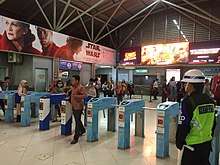
As of January 2019, there are 80 active and 4 inactive stations for KRL Commuterline. All the stations have commercial zones of various sizes for operating retail stores, chain shops, and ATM booth. The stations have prayer place, toilets and dispensary for emergency health service. Stations have manual ticket counters as well as automated ticket vending machines since 2017 .[39] Started on 15 January 2019, all stations have free Wi-Fi service facility for passengers.[40]
List of stations
Bold: Terminus or transit stations
Italic: Closed for Commuterline, open for intercity trains
Strikethrough: Closed for all services
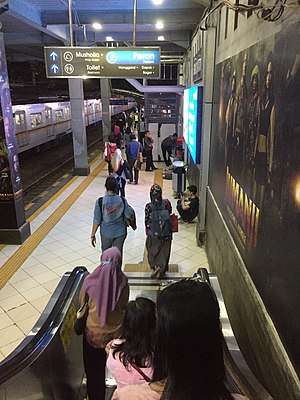
† Some trains starts and terminates here ^ For northbound (to Depok/ Bogor) trains only; southbound (to Jatinegara) trains does not stop there. | |
List of major stations
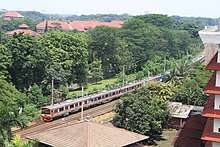
Below are the list of main and terminus stations, some of them also servicing intercity train lines.
| Station | Establishment | Type | Line(s) | Intercity/Local station |
|---|---|---|---|---|
| Jakarta Kota | 1926 | Commuter Terminus and Transit, and Intercity Terminus | Yes | |
| Gambir | 1884 | Intercity Terminusa | Yes | |
| Manggarai | 1918 | Commuter main transit | Yes | |
| Jatinegara | 1910 | Commuter terminus, transit and East Westbound Intercity stopb | Yes | |
| Tanah Abang | 1910 | Commuter terminus and transit | Yes | |
| Duri | 1899 | Commuter terminus and transitc | Yes | |
| Kampung Bandan | N/A | Commuter transit | No | |
| Pasar Senen | 1925 | Intercity terminus, Westbound Local stop and Northbound Commuter stopd | Yes | |
| Depok | 1881 | Commuter terminus | No | |
| Bogor | 1881 | Commuter and South Local terminus (Bogor Paledang station)b | Yes | |
| Bekasi | 1887 | Commuter terminus, East Suburban transit and East Intercity transit (night-time only) | Yes |
- ^a Currently, Gambir station does not serve as commuter stop, instead focusing on intercity train services in Gambir. Passengers who travel to areas near Merdeka Square, could depart at the nearby Gondangdia or Juanda stations.
- ^b South local trains (operated by PTKA, serving trips from Bogor to Sukabumi/Cianjur) starts and ends from Bogor Paledang, within walking distance from Bogor station.
- ^c Duri Station is planned to be the transit for Airport Commuter Train, which was under construction in 2014 and started operation in 2017.
- ^d Pasar Senen station only serve the Jatinegara – Depok/Bogor commuter service, while the Bogor/Depok – Jatinegara service does not stop here.
Rolling stock
KRL Jabodetabek rolling stocks are composed of second-hand rail cars imported from Japan of Tokyo Metro, Toyo Rapid, JR East, and Tokyu. Domestically made air-conditioned cars produced by Industri Kereta Api (INKA) air-conditioned are no longer in service. Trains are generally formed of 8, 10, or 12 cars, with a capacity of 80–110 passengers per car. KRL CommuterLine had 1,020 cars as of July 2019.[42]
Train without air conditioning (mainly economy class) are no longer operated as KCI (the operator) begins the single-service operation of air-conditioned trainsets. One set of ex-economy class (Holec) has been retrofitted with air conditioning by INKA.
Toei 6000 series, which began service in 2000, was the first air-conditioned train type to be scrapped in December 2015. They are replaced by a huge influx of newer secondhand 205 series trains.[43]
Since 1 January 2016, the ex-JR East 103 series were also retired from service.
Non-air-conditioned rolling stock (all retired since 2013)
- KRL Ekonomi BN-Holec (retired, some modified to become diesel commuter trains)
- KRL Ekonomi Rheostat (scrapped or stored)
- KRL Hitachi (scrapped or stored)
- KRL ABB Hyundai (retired, some modified to become diesel commuter trains)
Air-conditioned rolling stock
- 203 series (ex-JNR/JR East Joban Line rolling stock, 2011–present)
- 205-0 series (ex-JR East Saikyo Line, Yokohama Line, Nambu Line, and Musashino Line rolling stock, 2013–present) and 205-5000 series (ex-Musashino Line rolling stock, 2018–present)
- Tokyu 8000 series (ex-Tokyu Tokyu Den-en-toshi Line and Tokyu Oimachi Line rolling stock, 2006–present)
- Tokyu 8500 series (ex-Tokyu Den-en-toshi Line and Oimachi Line rolling stock, 2006–present)
- Tokyo Metro 05 series (ex-Tokyo Metro Tōzai Line rolling stock, 2010–present)
- Tokyo Metro 6000 series (ex-Tokyo Metro Chiyoda Line rolling stock, 2011–present)
- Tokyo Metro 7000 series (ex-Tokyo Metro Yūrakuchō Line rolling stock, 2011–present)
Retired air-conditioned rolling stock
- 103 series (ex-JNR/JR East Musashino Line rolling stock, 2004–2016)
- Toei 6000 series (ex-Toei Mita Line rolling stock, 2000–2016)
- Tōyō Rapid 1000 series (ex-Tōyō Rapid Railway line rolling stock, 2007–2019)
- Tokyo Metro 5000 series (ex-Tokyo Metro Tōzai Line rolling stock, 2007– January 2020)
- KRLI (PT. INKA, 1994–2015)
- KRL Holec AC (former KRL Ekonomi Holec trains retrofitted with AC from 1994 to 2001, currently suspended)
- KRL i9000 (INKA in cooperation with Bombardier with financing by KfW, currently suspended)Waiting to be KRL Jogja-Solo
Incidents and accidents
- 9 December 2013 – A train serving KRL Serpong-Jakarta line (former Tokyo Metro 7000 series rolling stock) collided with Pertamina tanker truck at Bintaro Permai railway intersection, Jakarta. Seven people (including the three train drivers) were killed in the crash.[44][45]
- 23 September 2015 – Two electric trains (KRL 1154 and KRL 1156 which are the former 205 series rolling stock units) collided at Juanda Station. No one was killed, but 42 passengers were hurt, with some required intensive treatment.[46]
Gallery
Rolling stock
 Former Tokyo Metro Tozai Line 05 series
Former Tokyo Metro Tozai Line 05 series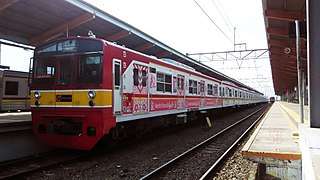 Former Joban Line 203 series
Former Joban Line 203 series Former Yokohama Line 205 series
Former Yokohama Line 205 series Former Toyo Rapid Railway Line 1000 series
Former Toyo Rapid Railway Line 1000 series Former Tokyo Metro Tozai Line 5000 series
Former Tokyo Metro Tozai Line 5000 series Former Tokyo Metro Chiyoda Line 6000 series
Former Tokyo Metro Chiyoda Line 6000 series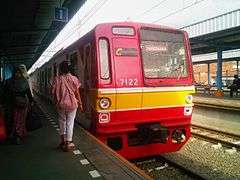 Tokyo Metro 7000 series
Tokyo Metro 7000 series Former Tokyu Toyoko Line 8000 series
Former Tokyu Toyoko Line 8000 series Former Tokyu Den-en-toshi Line 8500 series
Former Tokyu Den-en-toshi Line 8500 series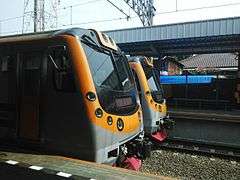 Locally built i9000 series EMU
Locally built i9000 series EMU
Stations
- Palmerah Station
- Tanah Abang Station
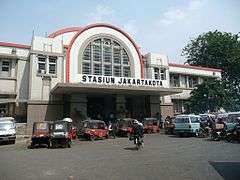 Jakarta Kota Station
Jakarta Kota Station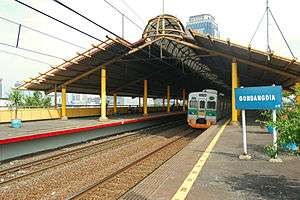 Gondangdia Station
Gondangdia Station
See also
References
- "Commuter line passengers hits 1 million".
- "Wow, Penumpang KRL Tembus 1 Juta Per Hari".
- "'Government subsidy unequal to commuter train passenger target'".
- "Jakarta's Commuter Line Train Gets Ready for More Passengers in 2018".
- "Tentang Kami".
- "State-run commuter line operator PT KCJ transforms into PT KCI". The Jakarta Post. Retrieved 20 September 2017.
- "Info Perusahaan".
- Agustin Setyo Wardani (3 February 2015). "2014, Sebanyak 200 Juta Orang Naik Kereta Jabodetabek".
- "Commuter Line Passes Milestone of 1m Daily Passengers". Jakarta Globe. Retrieved 21 November 2019.
- "Hikayat Jalur Kereta Api Listrik di Indonesia". CNN Indonesia. Retrieved 22 January 2017.
- "Sejarah Pembangunan Kereta Rel Listrik di Jakarta". Jakarta by Train. 7 March 2014. Retrieved 22 January 2017.
- Media, Kompas Cyber (3 October 2016). "Putaran Roda KRL, Bonbon, hingga KfW". KOMPAS.com. Retrieved 22 January 2017.
- Faris (17 January 2016). "Perjalanan KRL Seri 6000 Hibah eks-Toei, Setelah 15 Tahun - KAORI Nusantara". KAORI Nusantara. Retrieved 22 January 2017.
- "KRL Lintas Tanah Abang Diperpanjang Hingga Maja | Suara Pembaruan". sp.beritasatu.com. Retrieved 14 October 2017.
- Syailendra. "KRL Ekonomi Non-AC Dihapus Sejak Hari Ini". Tempo.co. Retrieved 13 March 2014.
- "Penambahan Jadwal Commuter Line dan Ancaman Kemacetan". 27 March 2015.
- Ronald. "Jalur Nambo resmi beroperasi, penumpang masih sepi | merdeka.com". merdeka.com. Retrieved 14 October 2017.
- Sulistyo, Bayu Tri (23 December 2015). "Yuk Kita Lihat Serunya Hari Pertama Pink Line!". Railway Enthusiast Digest (in Indonesian). Retrieved 19 December 2017.
- Idris, Muhammad. "Pengumuman! KRL Cikarang Mulai Beroperasi 8 Oktober". detikfinance. Retrieved 14 October 2017.
- "PT KCJ: Keterlambatan KRL Sudah di Bawah 10 Menit". 6 July 2015.
- Aliansyah, Muhammad Agil (5 March 2014). "KCJ mulai operasikan kereta terpanjang seri 205". Merdeka.com (in Indonesian). Retrieved 19 December 2017.
- PT Kereta Commuter Indonesia (2016). "Tahun 2016, PT KCJ Tambah 200 Gate dan Operasikan 18 Rangkaian KRL Formasi 12 Kereta" (in Indonesian). Retrieved 19 December 2017.
- "Commuter line to operate more train cars to boost number of passengers". The Jakarta Post. Retrieved 8 January 2018.
- Media, Kompas Cyber. "5 Desember, Pola Jalur Melingkar KRL Beroperasi - Kompas.com". KOMPAS.com. Retrieved 14 October 2017.
- Ronald. "Jalur Nambo resmi beroperasi, penumpang masih sepi | merdeka.com". merdeka.com. Retrieved 14 October 2017.
- "KRL Rangkasbitung - TanahAbang Beroperasi Penuh Mulai 1 April 2017". KRL. Retrieved 14 October 2017.
- Liputan6.com. "8 KRL Bekasi-Jakarta Kota Pindah Lewat Pasar Senen, Ini Jadwalnya". liputan6.com. Retrieved 14 October 2017.
- Fadhli, Faris (22 December 2015). "Lintas Jakarta Kota - Tanjung Priok Dibuka, KRL Mulai Beroperasi". KAORI Nusantara. Retrieved 14 October 2017.
- Rudi, Alsadad (9 January 2016). "Ini Cara Membeli Tiket di "Vending Machine" KRL - Kompas.com". KOMPAS.com (in Indonesian). Retrieved 11 April 2018.
- Post, The Jakarta. "Commuters welcome KCJ's cheaper train fares". The Jakarta Post. Retrieved 4 April 2017.
- Jum'at, Yan Yusuf (5 January 2018). "Denda THB Commuter Line Dihapus, Saldo Minimal KMT Turun Jadi Rp5 Ribu". SINDOnews (in Indonesian). Retrieved 11 April 2018.
- Widyanuratikah, Inas (8 January 2018). "Saldo Minimum KMT untuk KRL Kini Hanya Rp 5.000". Republika (in Indonesian). Retrieved 11 April 2018.
- "Naik KRL Sekarang Bisa Pakai Tiga Kartu Prabayar Bank BUMN". 16 June 2014.
- Administrator. "Kartu Flazz BCA Kini Dapat Digunakan Untuk Transaksi Perjalanan KRL | BERITA TERKINI". www.krl.co.id. Archived from the original on 24 April 2016. Retrieved 12 April 2016.
- "Mulai 1 Oktober, Tarif KRL Jabodetabek Naik". Retrieved 13 October 2016.
- "Pemerintah Beri Subsidi Kereta Rp 1,8 T di 2016, Rp 1,1 T Untuk KRL". detikfinance. Retrieved 12 April 2016.
- Post, The Jakarta. "Cheaper train fares and e-tickets at KCJ". TheJakartaPost.com. Retrieved 4 April 2017.
- "Train commuters up by 30 percent". 8 July 2013.
- "More KRL ticket vending machines to be installed in Jakarta". The Jakarta Post. Retrieved 15 January 2019.
- "Pengalaman Mencoba Akses WiFi Gratis di Stasiun Jabodetabek..." Kompas. Retrieved 15 January 2019.
- Jadwal Terbaru KRL – Update 21 November 2017
- "Commuter line operator procures more trains to serve ever-growing number of passengers". The Jakarta Post. Retrieved 12 August 2019.
- "都営6000、Depok電車区にてオフレール作業開始!!(11月23日~) - JABODETABEK COMMUTERS NEWS". Cocolog-nifty.com. Retrieved 4 April 2017.
- "Seven people killed in accident collision of a tanker truck vs KRL - Republika Online". Republika.co.id. Retrieved 4 April 2017.
- "KRL collision fatalities and increased tanker truck". Blogspot.my. Retrieved 4 April 2017.
- Post, The Jakarta. "KRL collision in Jakarta caused by 'human error' says KAI". TheJakartaPost.com. Retrieved 4 April 2017.
External links
| Wikimedia Commons has media related to Kereta Commuter Indonesia. |
- KRL Jabodetabek website (in Indonesian)
- Jabotabek Railnews (in Japanese)
- KRL Jabodetabek (in Japanese)
